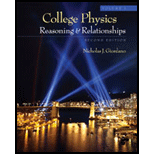
Concept explainers
(a)
The acceleration due to gravity at a height
(a)
Answer to Problem 71P
The acceleration due to gravity is
Explanation of Solution
The gravitational force of an object on the Earth’s surface is determined by Newton’s universal law of gravitation. Which is given by,
Here,
Force of gravity is the only force acting on the station so that for an object in orbit it must be providing the entire centripetal acceleration,
The acceleration of the station when it is moving in a circle must be centripetal acceleration which is given by,
The expression for the time period is given by,
Conclusion:
The orbit of the station is equal to Earths radius plus height above the surface so that,
Substitute
Substitute
Substitute
Therefore, The acceleration due to gravity is
(b)
The orbital velocity and period of the telescope.
(b)
Answer to Problem 71P
The orbital velocity is
Explanation of Solution
Substitute
Conclusion:
Substitute
Therefore, The orbital velocity is
Want to see more full solutions like this?
Chapter 5 Solutions
College Physics, Volume 1
- The astronaut orbiting the Earth in Figure P3.27 is preparing to dock with a Westar VI satellite. The satellite is in a circular orbit 600 km above the Earth’s surface, where the free-fall acceleration is 8.21 m/s2. Take the radius of the Earth as 6 400 km. Determine the speed of the satellite and the time interval required to complete one orbit around the Earth, which is the period of the satellite. Figure P3.27arrow_forwardOn a planet whose radius is 1.2107m , the acceleration due to gravity is 18m/s2 . What is the mass of the planet?arrow_forwardCheck Your Understanding Assume you are in a spacecraft in orbit about the Sun at Earth’s orbit, but far away from Earth (so that it can be ignored). How could you redirect your tangential velocity to the radial direction such that you could then pass by Mars’s orbit? What would be required to change just the direction of the velocity?arrow_forward
- Show that for eccentricity equal to one in Equation 13.10 for conic sections, the path is a parabola. Do this by substituting Cartersian coordinates, x and y, for the polar coordinates, r and , and showing that it has the general form for a parabola, x=ay2+by+c .arrow_forwardCalculate the effective gravitational field vector g at Earths surface at the poles and the equator. Take account of the difference in the equatorial (6378 km) and polar (6357 km) radius as well as the centrifugal force. How well does the result agree with the difference calculated with the result g = 9.780356[1 + 0.0052885 sin 2 0.0000059 sin2(2)]m/s2 where is the latitude?arrow_forwardIf a planet with 1.5 times the mass of Earth was traveling in Earth’s orbit, what would its period be?arrow_forward
- Model the Moons orbit around the Earth as an ellipse with the Earth at one focus. The Moons farthest distance (apogee) from the center of the Earth is rA = 4.05 108 m, and its closest distance (perigee) is rP = 3.63 108 m. a. Calculate the semimajor axis of the Moons orbit. b. How far is the Earth from the center of the Moons elliptical orbit? c. Use a scale such as 1 cm 108 m to sketch the EarthMoon system at apogee and at perigee and the Moons orbit. (The semiminor axis of the Moons orbit is roughly b = 3.84 108 m.)arrow_forwardThe “mean” orbital radius listed for astronomical objects orbiting the Sun is typically not an integrated average but is calculated such that it gives the correct period when applied to the equation for circular orbits. Given that, what is the mean orbital radius in terms of aphelion and perihelion?arrow_forwardThe International Space Station (ISS) is in a 250-mile high orbit around Earth. What is its orbital period in minutes and its orbital speed (assuming a circular orbit)?arrow_forward
- Two newly discovered planets follow circular orbits around a star in a distant part of the galaxy. The orbital speeds of the planet s are determined to be 43.3 km/s and 58.6 km/s. The slower planet's orbital period is 7.60 years. (b) What is the orbital period of the faster planet, in years?arrow_forwardThe latest Space X mission took 4 astronauts to a circular orbit around the Earth, The orbital speed for the spacecraft was 4.75 mi/s at 590 km above the earth surface. Use the information provided and the graph shown below to estimate how many hours it took for the craft to circle the Earth once at this speed. Length of a circular orbit as a function of elevation 45000 44000 43000 42000 41000 40000 200 400 600 800 h, km C, kmarrow_forwardASAParrow_forward
 University Physics Volume 1PhysicsISBN:9781938168277Author:William Moebs, Samuel J. Ling, Jeff SannyPublisher:OpenStax - Rice University
University Physics Volume 1PhysicsISBN:9781938168277Author:William Moebs, Samuel J. Ling, Jeff SannyPublisher:OpenStax - Rice University Principles of Physics: A Calculus-Based TextPhysicsISBN:9781133104261Author:Raymond A. Serway, John W. JewettPublisher:Cengage Learning
Principles of Physics: A Calculus-Based TextPhysicsISBN:9781133104261Author:Raymond A. Serway, John W. JewettPublisher:Cengage Learning Classical Dynamics of Particles and SystemsPhysicsISBN:9780534408961Author:Stephen T. Thornton, Jerry B. MarionPublisher:Cengage Learning
Classical Dynamics of Particles and SystemsPhysicsISBN:9780534408961Author:Stephen T. Thornton, Jerry B. MarionPublisher:Cengage Learning Glencoe Physics: Principles and Problems, Student...PhysicsISBN:9780078807213Author:Paul W. ZitzewitzPublisher:Glencoe/McGraw-Hill
Glencoe Physics: Principles and Problems, Student...PhysicsISBN:9780078807213Author:Paul W. ZitzewitzPublisher:Glencoe/McGraw-Hill Physics for Scientists and Engineers: Foundations...PhysicsISBN:9781133939146Author:Katz, Debora M.Publisher:Cengage Learning
Physics for Scientists and Engineers: Foundations...PhysicsISBN:9781133939146Author:Katz, Debora M.Publisher:Cengage Learning Stars and GalaxiesPhysicsISBN:9781305120785Author:Michael A. Seeds, Dana BackmanPublisher:Cengage Learning
Stars and GalaxiesPhysicsISBN:9781305120785Author:Michael A. Seeds, Dana BackmanPublisher:Cengage Learning





